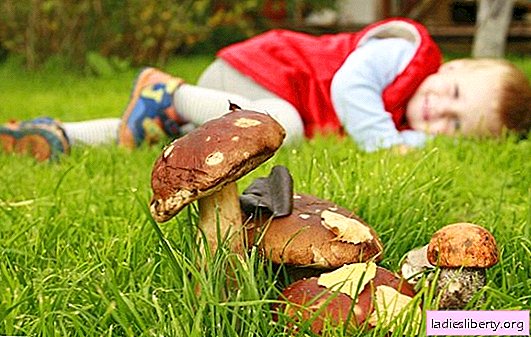
Mushroom poisoning accounts for 4% of all human food poisoning. It is especially often observed in the mushroom season (summer and autumn), when people begin to collect these products on their own. Consider in more detail the signs of mushroom poisoning and methods of treating this condition.
Poisoning with poisonous mushrooms: symptoms and causes
Studies show that you can poison not only poisonous mushrooms, but also edible if they were not properly stored or were prepared in violation of culinary rules.
The following causes of possible mushroom poisoning are distinguished:
1. The use of a poisonous type of fungus, which has strong toxic effects on the body.
2. Eating a mushroom that has been affected by insects or parasites (the so-called mushroom flies).
3. The use of mushroom dishes along with alcohol can cause severe toxic damage to the body and, accordingly, poisoning.
4. Add to the dish mushrooms that were collected near roads, in landfills or in areas where harmful substances accumulate for humans.
5. The use of those types of mushrooms that belong to the conditionally edible categories.
Mushroom poisoning can be divided into three such stages:
1. The first stage lasts from six to twenty-four hours. During this time, the poison from the poisonous fungus is absorbed into human blood, which leads to nausea and high fever. Also, the patient may experience abdominal cramps and diarrhea.
2. The second stage of poisoning lasts from two to three days. During this time (for example, with poisonous toadstool poisoning), a person's symptoms may subside a little, which will create a false impression of recovery.
3. The third stage is the most dangerous, because if until this time a person does not receive the necessary medical care, then his body may develop irreversible consequences (coma, impaired liver function, impaired vision, etc.).
There are the following signs of mushroom poisoning, depending on the type of these products:
1. When using red mushroom, signs of poisoning will appear after two hours. Among the symptoms can be identified:
• nausea and vomiting;
• colic in the stomach;
• abdominal cramp;
• heavier breathing;
• lacrimation;
• a sharp decrease in blood pressure;
• narrowing of the pupils;
• cramps;
• increased heart rate.
2. If you use improperly cooked morels, a person may have diarrhea, loss of consciousness, cramps and nausea. Sometimes there is also an increase in the liver and spleen.
3. Poisoning with poisonous mushrooms with hallucinogenic properties can cause such symptoms in case of poisoning:
• dizziness;
• drowsiness;
• headache
• nausea;
• feeling of euphoria;
• speech impairment;
• hallucinations;
• arterial hypertension;
• delusional states;
• loss of consciousness.
The above signs of mushroom poisoning can also be supplemented by yellowing of the skin (development of jaundice) and kidney damage.
It is important to know, that poisoning with poisonous mushrooms in children also has acute symptoms and is usually more difficult than in adults (a high risk of death). For this reason, doctors do not recommend giving mushrooms to children in any form for at least 12 years.
Moreover, these products are difficult to digest, so people with gastrointestinal diseases are categorically contraindicated for use.
Another feature of poisonous mushrooms isthat they are extremely dangerous during pregnancy, as their toxic substances can penetrate the placenta and harm the fetus. As a result of this, in case of headache, nausea, diarrhea and high fever, a woman in a special situation needs to see a doctor as soon as possible.
First aid for mushroom poisoning
First aid for mushroom poisoning involves the following:
1. If dangerous symptoms of poisoning appear, you should immediately call an ambulance. Before their arrival, you can wash the patient’s stomach with a weak solution of potassium permanganate.
2. Next, you need to give a person a large dose of sorbents to drink (per 10 kg of weight - 1 tablet of activated carbon).
3. If there is no diarrhea, then you can drink a laxative.
4. To reduce the risk of circulatory disorders, a warm compress should be applied to the patient's legs.
5. You should constantly give a person water or tea in order to "dilute" the toxic effects of the poison in the body. In this way, poisoning can be reduced.
6. It is important to monitor the general condition of the patient, measure his pressure and temperature.
It is impossible to inject or give a person any medications without a doctor’s prescription (unless you are a doctor yourself), since this can only worsen his condition.
Treatment for mushroom poisoning: diagnostic methods
Before starting treatment for poisoning, it is important to identify the type of fungus that caused this condition. To do this, carry out the following examinations:
1. History and examination of the patient.
2. Palpation of the abdomen.
3. Taking a general analysis of blood and urine.
4. Blood test for toxins.
5. Behavior of electroencephalogy.
6. Advanced biochemical blood test.
7. Identification of the degree of damage to the liver and other organs of ultrasound.
The traditional treatment of poisoning with poisonous mushrooms involves the following:
1. The patient undergoes an urgent gastric lavage. Moreover, this procedure can be repeated several times.
2. If the patient's condition is satisfactory, then he is still observed for several days. If a person has deterioration in the cardiovascular, nervous or digestive systems, then in this case he will be given the appropriate symptomatic treatment.
3. If the patient's condition worsens sharply (a person has hallucinations, he falls into a coma, or suffers from constant diarrhea), then in this case he may be prescribed intravenous antibiotics, hemosorption or forced diuresis.
4. If the poisoning was caused by a red fly agaric, then the patient is given an antidote in the form of 1% Anthropin. You need to stab it every four hours.
5. To eliminate the bronchospasm that has arisen, doctors use the drug Isadrin. You need to drive it in standard doses.
6. To maintain heart function, caffeine is administered.
It is important to know, that in the treatment of poisoning with poisonous mushrooms, acid-based preparations can not be used, since they will only contribute to the absorption of toxic substances in the body. This will further prolong the therapy and may significantly worsen the patient's condition.
7. If the poisoning was caused by the use of a pale toadstool or throat, then such treatment should be aimed at restoring the water balance in the body and preventing the development of a collaptoid state. To do this, use plasma substitutes (they are administered dropwise up to five liters per day). The best drugs of this drug group are Ringer's solution and saline. You can also sometimes use antibiotics, but only if indicated.
As for homeopathy, they are rarely used in case of poisoning, since such drugs are not yet fully understood, and elimination of poisoning requires immediate treatment.
In general, with severe intoxication of the body, the success of treatment will largely depend on the speed of medical care.
There is also a folk treatment for mushroom poisoning. It can be carried out only after medical care and consultation with a doctor. The best folk methods are:
1. Taking cocktails made from milk and raw egg white neutralizes the effects of toxins in the body.
2. Reception of juice from potatoes.
3. Rice broth or the use of boiled rice helps very well. It acts as a sorbent.
4. Reception of chamomile broth or strong black tea.
Treatment for mushroom poisoning: prevention methods
Often, mushroom poisoning causes irreversible consequences, therefore, in order to prevent this, it is important to adhere to the following recommendations:
1. Do not pick mushrooms yourself, especially if you are not good at them. This is justified by the fact that among them there are a lot of so-called snag that look like edible mushrooms, although in fact they are poisonous.
2. If you doubt the quality or form of the mushroom, then it should not be put in a basket.
3. You cannot buy mushrooms in the markets, because there is no guarantee that they did not gather near roads or chemical plants.
4. You cannot cook mushrooms that have already begun to rot or have parasites in them, as they will remain poisonous even after heat treatment.
5. It is better not to eat stale mushrooms.
6. When picking mushrooms with children, you need to carefully monitor that the child does not accidentally try a raw mushroom. In general, it is advisable to hold children by the hand in the forest because of the risk of being bitten by an insect, snake, etc.
7. When picking mushrooms yourself, you need to look not only at the "top" of this product, but also at its plates under the cap.
8. It is not advisable to pick mushrooms in plastic bags, as they deteriorate faster in them.
9. You can not leave the processing of mushrooms "for later". Immediately after collection, they should be cleaned and boiled.
10. When using canned mushrooms, you should always pay attention to the shelf life of such a product. Also a hallmark of spoiled mushroom canned food is the swelling of the lid or the formation of mold on it.
11. Cooking mushrooms always needs a long time. It is advisable to boil them several times. Broth can not be added to soups. It needs to be poured.











